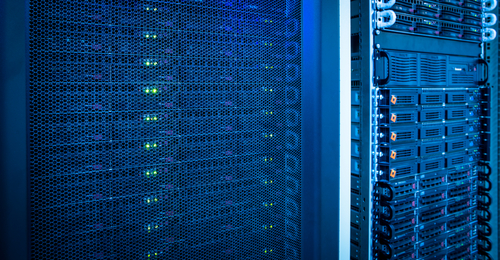
A new pair of reports paints an optimistic picture for the 10-Gbit Ethernet market—while noting that startups continue to face significant barriers to success. Released by
Crehan Research and
Heavy Reading, the reports cover both the data-center switch market and the companies actually manufacturing PHY components. Despite economic weakness in many regions, Crehan found the market posted quarter-over-quarter and year-over-year gains in the third quarter. "While no segment of the networking market is immune to the pressures of a weak economy, trends such as exponential growth in network traffic and storage, convergence, virtualization, and large Cloud and Web 2.0 data center models, as well as the mission critical and strategic nature of the data center, have resulted in continued investment and growth for data center switches," Seamus Crehan, president of Crehan Research, wrote in a statement. While Crehan declined to publicly release any market-share figures, the firm noted that Cisco still has a large revenue and port share lead, indicative of broad data center adoption of its Nexus 7000 modular/chassis switch as well as its Fixed/Top-of-Rack Nexus 5000 and 2000 lines. The firm also singled out Arista Networks and Extreme Networks for robust growth, noting that the latter had doubled its shipments. Other highlights included IBM, which saw strong growth and numerous associated share gains in the GbE, 10GbE and 40GbE blade/embedded switch segments (helped by the ramp-up of its PureSystems integrated server, storage and networking solutions). Fibre Channel switch revenue for 2012 is expected to exceed that of 2011, although Crehan found that revenues declined sequentially as port growth was offset by price declines. The Heavy Reading report, covering the 10GBase-T or 10-gigabit Ethernet market, found that the number of companies investing in the market has dropped—making things potentially difficult for startups in need of cash. "Following significant consolidation, semiconductor vendors continue to make significant investments, including lower power devices for 10GBase-T using 28nm technology," Simon Stanley, research analyst for
Heavy Reading Components Insider and author of the report, wrote in a statement. "The success of vendors and the 10GBase-T market in general will depend on the 40nm devices and solutions covered in this report and on a successful transition to 28nm for the next generation of 10GBase-T PHY and integrated controller/MAC and 10GBase-T PHY devices." The report also found, in no particular order:
- 10GBase-T demand has been driven by the shift to Intel Romley processors in server platforms.
- High-density 48-port switches are enabled by the latest quad-port 10GBase-T PHY devices.
- Integrated controller/MAC with single- or dual-port 10GBase-T PHY is driving down the cost of 10GE adapters and LOM modules.
- 40nm PHYs are delivering per-port power consumption at less than 2W for 10-meter connections.
- 28nm solutions are expected to further drive down power consumption and latency.
- Significant consolidation has taken place, with Aquantia now the only 10GBase-T startup.
The industry as a whole is also investing in next-generation products, including 28nm devices and solutions for 40GE.
Image: lightpoet/Shutterstock.com
 A new pair of reports paints an optimistic picture for the 10-Gbit Ethernet market—while noting that startups continue to face significant barriers to success. Released by Crehan Research and Heavy Reading, the reports cover both the data-center switch market and the companies actually manufacturing PHY components. Despite economic weakness in many regions, Crehan found the market posted quarter-over-quarter and year-over-year gains in the third quarter. "While no segment of the networking market is immune to the pressures of a weak economy, trends such as exponential growth in network traffic and storage, convergence, virtualization, and large Cloud and Web 2.0 data center models, as well as the mission critical and strategic nature of the data center, have resulted in continued investment and growth for data center switches," Seamus Crehan, president of Crehan Research, wrote in a statement. While Crehan declined to publicly release any market-share figures, the firm noted that Cisco still has a large revenue and port share lead, indicative of broad data center adoption of its Nexus 7000 modular/chassis switch as well as its Fixed/Top-of-Rack Nexus 5000 and 2000 lines. The firm also singled out Arista Networks and Extreme Networks for robust growth, noting that the latter had doubled its shipments. Other highlights included IBM, which saw strong growth and numerous associated share gains in the GbE, 10GbE and 40GbE blade/embedded switch segments (helped by the ramp-up of its PureSystems integrated server, storage and networking solutions). Fibre Channel switch revenue for 2012 is expected to exceed that of 2011, although Crehan found that revenues declined sequentially as port growth was offset by price declines. The Heavy Reading report, covering the 10GBase-T or 10-gigabit Ethernet market, found that the number of companies investing in the market has dropped—making things potentially difficult for startups in need of cash. "Following significant consolidation, semiconductor vendors continue to make significant investments, including lower power devices for 10GBase-T using 28nm technology," Simon Stanley, research analyst for Heavy Reading Components Insider and author of the report, wrote in a statement. "The success of vendors and the 10GBase-T market in general will depend on the 40nm devices and solutions covered in this report and on a successful transition to 28nm for the next generation of 10GBase-T PHY and integrated controller/MAC and 10GBase-T PHY devices." The report also found, in no particular order:
A new pair of reports paints an optimistic picture for the 10-Gbit Ethernet market—while noting that startups continue to face significant barriers to success. Released by Crehan Research and Heavy Reading, the reports cover both the data-center switch market and the companies actually manufacturing PHY components. Despite economic weakness in many regions, Crehan found the market posted quarter-over-quarter and year-over-year gains in the third quarter. "While no segment of the networking market is immune to the pressures of a weak economy, trends such as exponential growth in network traffic and storage, convergence, virtualization, and large Cloud and Web 2.0 data center models, as well as the mission critical and strategic nature of the data center, have resulted in continued investment and growth for data center switches," Seamus Crehan, president of Crehan Research, wrote in a statement. While Crehan declined to publicly release any market-share figures, the firm noted that Cisco still has a large revenue and port share lead, indicative of broad data center adoption of its Nexus 7000 modular/chassis switch as well as its Fixed/Top-of-Rack Nexus 5000 and 2000 lines. The firm also singled out Arista Networks and Extreme Networks for robust growth, noting that the latter had doubled its shipments. Other highlights included IBM, which saw strong growth and numerous associated share gains in the GbE, 10GbE and 40GbE blade/embedded switch segments (helped by the ramp-up of its PureSystems integrated server, storage and networking solutions). Fibre Channel switch revenue for 2012 is expected to exceed that of 2011, although Crehan found that revenues declined sequentially as port growth was offset by price declines. The Heavy Reading report, covering the 10GBase-T or 10-gigabit Ethernet market, found that the number of companies investing in the market has dropped—making things potentially difficult for startups in need of cash. "Following significant consolidation, semiconductor vendors continue to make significant investments, including lower power devices for 10GBase-T using 28nm technology," Simon Stanley, research analyst for Heavy Reading Components Insider and author of the report, wrote in a statement. "The success of vendors and the 10GBase-T market in general will depend on the 40nm devices and solutions covered in this report and on a successful transition to 28nm for the next generation of 10GBase-T PHY and integrated controller/MAC and 10GBase-T PHY devices." The report also found, in no particular order:

